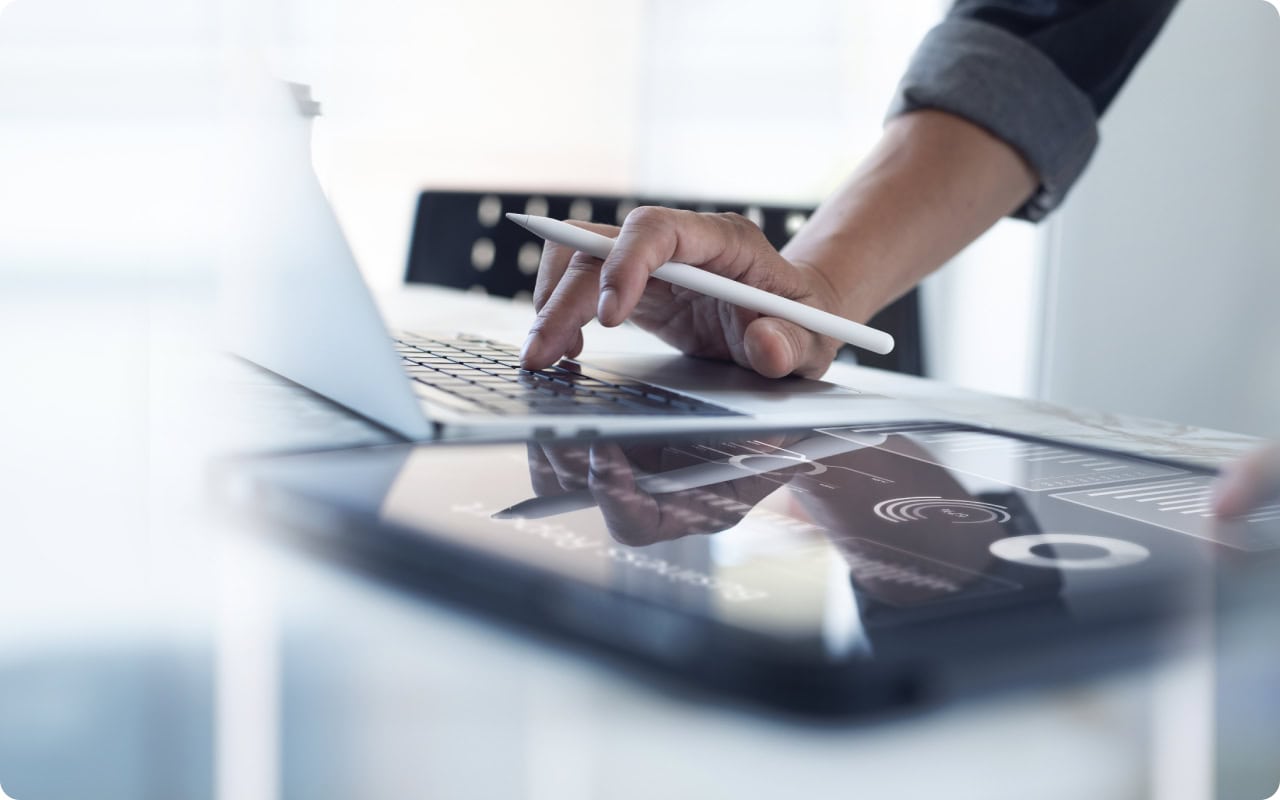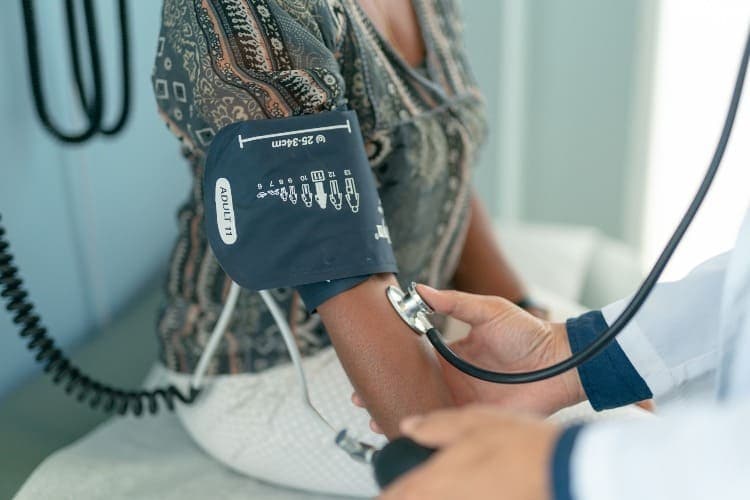
Understanding Blood Pressure
This page will help you find ways to prevent and treat high blood pressure, also known as hypertension. You will learn how to check your blood pressure (BP), live a healthy life, and understand your medicines.
Understanding Blood Pressure
Checking Your Blood Pressure At Home
Exercise and Blood Pressure
Salt and Blood Pressure
Blood Pressure and Weight
Common Medicines for Blood Pressure
Understanding Blood Pressure
Your blood pressure reading has 2 numbers. The top number is called systolic blood pressure. It is the pressure when the heart squeezes to pump blood to the rest of the body. The second, or bottom number, is known as diastolic blood pressure. It occurs when the heart relaxes.
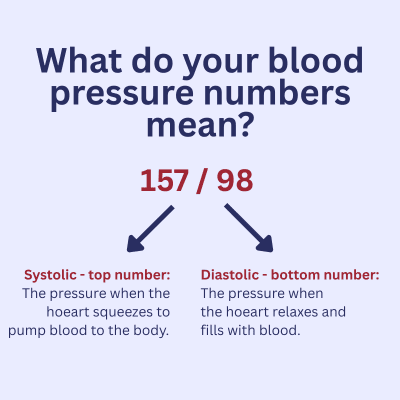
Blood Pressure
Your goal for blood pressure is less than 120 and less than 80. If you have diabetes or kidney problems, your nurse or doctor may have a different goal for you.
Always contact your nurse or doctor if your systolic—top—pressure is above 180 or your diastolic—bottom—pressure is above 110
Check Your Blood Pressure Numbers at Home
Checking your blood pressure at home will help your nurse or doctor or nurse know if your numbers are normal or high. Ask your doctor or nurse to help you find the correct size home blood pressure cuff and quality monitor. Do not use finger or wrist monitors.
Learn more about checking your blood pressure at home.
How to Lower Your Blood Pressure
- Aim for 30-60 minutes of activity each day. Learn more about exercise and blood pressure.
- Reach a healthy weight. Learn more about how to reach a healthy weight.
- Eat a healthy diet and eat less salt (sodium). Learn more about how to eat less salt.
You have the power to make changes to improve your health.
Learn About Your Medicines
- Most people with high blood pressure need at least two medicines to lower their blood pressure to a healthy level.
- Your doctor or nurse may need to change your medicines to find what works best for you. This is normal.
- If you don't feel well after taking medicine, call your doctor or nurse.
- Don't stop taking your medicine until you talk with your doctor or nurse.
Learn more about your blood pressure medicines.
How does high blood pressure affect your body?
- Your Brain - High blood pressure hurts the arteries leading to the brain and increases your risk for stroke (brain attack).
- Your Heart and Blood Vessels - High blood pressure hurts your heart and blood vessels and increases your risk for heart attack.
- Your Kidneys - High blood pressure hurts your kidneys and increases your risk for kidney failure.
Learn More
Explore these topics further to learn more about blood pressure.
Checking Your Blood Pressure At Home
Exercise and Blood Pressure
Salt and Blood Pressure
Blood Pressure and Weight
Common Medicines for Blood Pressure
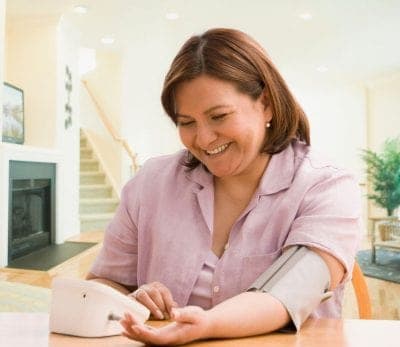
Checking Your Blood Pressure at Home
Checking your blood pressure at home will help your healthcare professional know if your numbers are normal or high.
Important Note: Blood pressure numbers are often lower at home than in the clinic. The goal for blood pressure at home is less than 120 (systolic) and less than 80 (diastolic).
Choose A Blood Pressure Monitor
- Choose a good home blood pressure device by asking your healthcare professional for advice.
- Blood pressure devices can be purchased at convenience stores and local pharmacies.
- Bring your device to your next appointment so your healthcare professional can check the measurement.
- Choose an approved device.
- To find the cuff size that is right for you, measure the size of your upper arm with a tape measure.
- If you do not have a tape measure, you can use a piece of string or ribbon to measure around your arm, then compare the length of the string or ribbon to a ruler to see what size cuff you need.
- You can also print out a paper measuring tape (PDF).
Before Taking a Reading
- Wait for 30 minutes after exercising, smoking, or drinking caffeine or alcohol.
- Go to the bathroom.
- Rest for at least 5 minutes
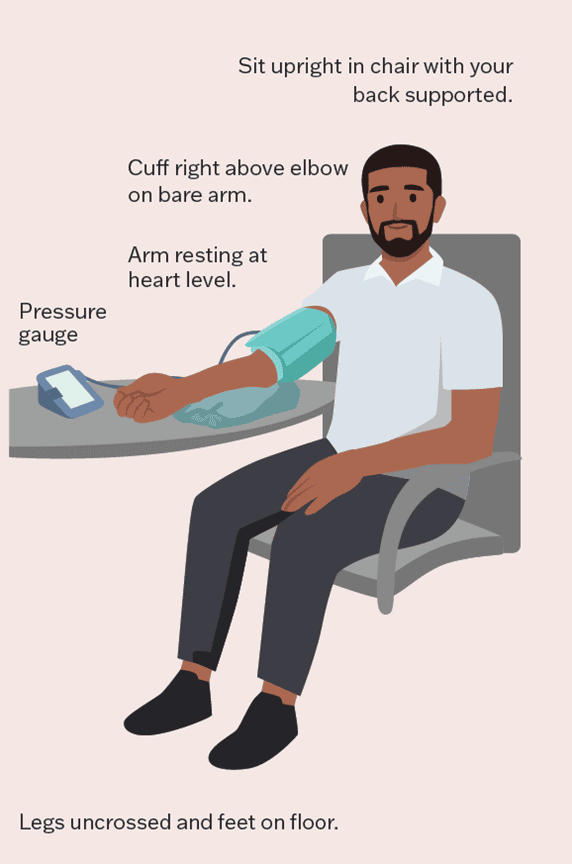
Taking Your Blood Pressure
- Take your blood pressure before you take any medicines.
- Measure your blood pressure 2 times a day for 7 days:
- Take 2-3 readings in the morning and 2-3 readings in the evening.
- Each reading should be 2 minutes apart.
- Measure in both arms the first time you use your device. Use the arm with the highest reading moving forward.
- Write down your readings, or print the numbers stored in your device.
- Ask your health care professional if there is a way to link to your electronic medical record.
- Bring your readings, or your device, to each health care visit.
Learn More
Explore these topics further to learn more about blood pressure.
Understanding Blood Pressure
Exercise and Blood Pressure
Salt and Blood Pressure
Blood Pressure and Weight
Common Medicines for Blood Pressure
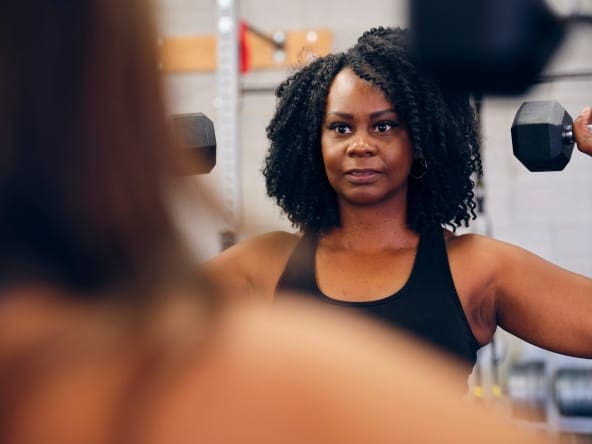
Blood Pressure and Exercise
Regular physical activity helps reduce your blood pressure. But it's normal for blood pressure to increase right after exercising. In order to get the most accurate reading, the best time to take your blood pressure is 30 minutes after exercising.
What Exercises Are Safe?
Always talk to your healthcare professional before starting or changing your exercise routine to find out what exercises are safe for you. You can also ask about a good pulse rate range and how to take your pulse. This is called your “Target Heart Range.”
Why Is Movement Good for You?
Any movement helps prevent heart attack and stroke by:
- Lowering your blood pressure
- Improving your cholesterol: lowering LDL, increasing HDL, lowering triglycerides.
- Controlling your blood sugar
- Helping you stay at a healthy weight and build muscle
- Reducing stress, depression, and anxiety
- Improving muscle strength, balance, and fitness
Movement Tips
- Aim for 150 minutes of movement per week. It is good goal to move at least 30 minutes per day at a moderate intensity (such as brisk walking). You can start slow and build up your time and speed.
- It is important to warm up before exercising and cool down afterward. Stretching and/or walking at a slow pace for 5 minutes will allow your heart rate and blood pressure to adjust safely.
- Add stretching, flexibility, and balance exercises to your routine. Yoga and Tai Chi are good examples.
- Consider joining a group exercise class at your local fitness club or gym where you can socialize and find a supportive environment.
- Resistive exercise is important as well. Using light weights and resistive bands help to build muscle and improve strength.
- Consider moving with a friend, neighbor, or significant other. Having someone to encourage your efforts and help with motivation will help both of you, and will be more interesting and fun!
- Most importantly, find a routine that you will enjoy. You are more likely to continue with a form of physical activity that is enjoyable.
Learn More
Explore these topics further to learn more about blood pressure.
Understanding Blood Pressure
Checking Your Blood Pressure At Home
Salt and Blood Pressure
Blood Pressure and Weight
Common Medicines for Blood Pressure
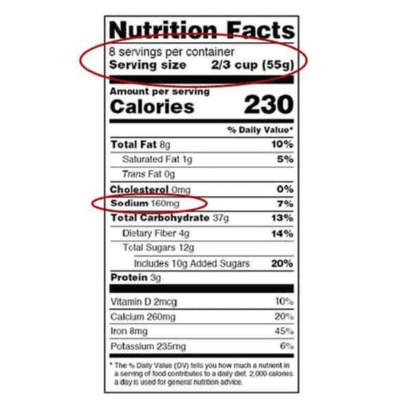
Blood Pressure and Salt
Minimizing the amount of salt (sodium) you eat can help lower your blood pressure. The recommended amount of sodium you should eat each day should be 1,500 milligrams (mg) or less.
Eat Less Salt
Most people consume 50% more salt than the recommended daily limit. It is important to know where the hidden sources of salt are found, such as in pre-packaged and restaurant food.
Top 10 Sources of Sodium in American Diets
- bread and rolls
- cold cuts and cured meats (such as bacon and sausage)
- pizza
- poultry (processed)
- canned soups, vegetables, fish (such as tuna and sardines)
- sandwiches such as hot dogs, hamburgers and submarine sandwiches that contain prepared meats
- cheese (especially hard cheeses)
- pasta dishes such as lasagna, spaghetti and pasta salad
- meat dishes including meatloaf, chili and stew
- snacks such as chips, pretzels, popcorn and crackers
10 Easy Steps for Cutting Sodium
- Read nutrition labels for serving size and mg of sodium. Choose foods with lower sodium.
- Cook your own food when you can. Don’t salt foods before or during cooking or eating.
- Add flavor without salt. Use herbs and spices.
- Choose fresh or frozen meats instead of processed meats. Check to see if salt water (saline) has been added.
- Use fresh, frozen, low sodium or no-salt-added canned vegetables.
- Rinse canned foods such as tuna, vegetables and beans to reduce salt.
- Choose fat-free or low-fat milk and milk products in place of processed cheese products and spreads.
- Choose unsalted or low-sodium nuts, seeds, chips and pretzels.
- Choose light or reduced-sodium ketchup, soy sauce, salad dressings, and seasonings. Try using olive oil and vinegar instead.
- At restaurants, ask for your meal to be prepared without salt and with sauces and dressings served ‘on the side. Smaller serving sizes also mean less salt.
- Take home half of your meal instead by filling up the “take out box” before you start eating!
Eat foods that are high in
potassium
Eating foods that are high in potassium is important for managing high blood pressure. This is because potassium help reduce sodium in your body through your urine.
However, eating a diet high in potassium may not be suitable for everyone, especially if you have kidney disease or are taking certain medicines. Check with your health care professional before you decide to increase potassium in your diet.
The recommended amount of potassium for men is 3,400 milligrams, and for women is 2,600 milligrams.
Learn More
Explore these topics further to learn more about blood pressure.
Understanding Blood Pressure
Checking Your Blood Pressure At Home
Exercise and Blood Pressure
Blood Pressure and Weight
Common Medicines for Blood Pressure
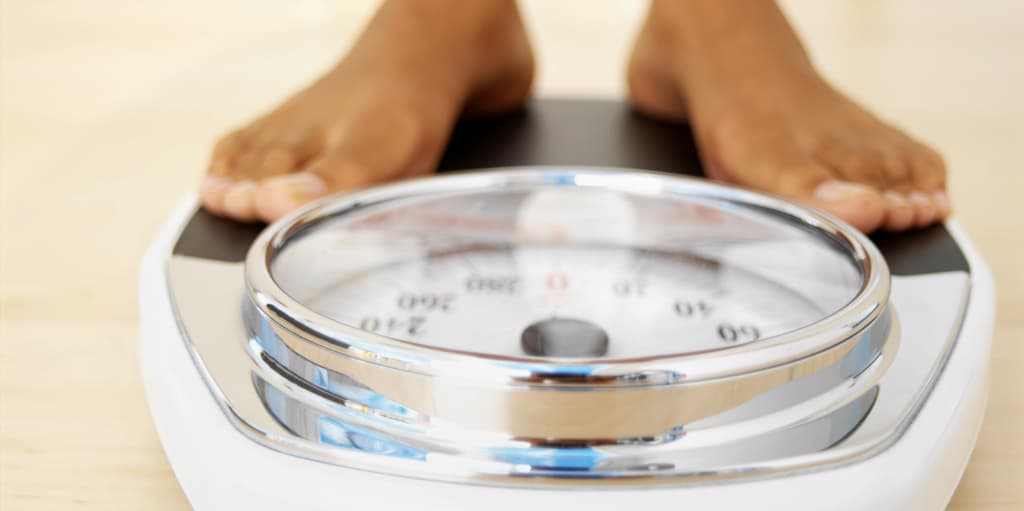
Blood Pressure and Weight
When you choose healthy foods, you can
help lower your blood pressure and also
reach, and stay at, a healthy weight.
Reach a Healthy Weight
- Choose your foods wisely and read food labels.
- Be mindful of portion sizes and keep a food diary to stay focused and aware of what you are eating.
- Limit the amount of alcohol you drink. No more than 1 drink a day for women, and 2 drinks a day for men. Drinking no alcohol at all is even better.
- Try not to shop when you are hungry – we tend to over buy unhealthy foods when we are hungry.
- Make a grocery list, and then stick to it when shopping.
Tips for Reaching a Health Weight
- Count your calories, then eat 100 less calories a day.
- Walk 30-60minutes per day. Gradually work up to 10,000 steps per day by using a pedometer or other step tracking device.
- Eat smaller portions. Portion size for starch and protein meat should
not be larger than a deck of cards. - Fill up on salads, vegetables, or low sodium soups.
- Drink a large glass of water before your meal.
- Limit processed foods as they contain added salt, sugar, and trans fats.
- Do not eat snacks directly from the bag. Measure out the portion into a bowl to avoid overeating
Ways to Save 100 Calories
- Eat 1 cup of whole grain cereal instead of 2.
- Add lettuce and tomato (instead of cheese) to your sandwich.
- Use fat-free salad dressing or olive oil and spices
- Use mustard instead of mayo on sandwiches.
- Order thin or vegetable crust instead of thick crust pizza.
- Eat fresh fruit instead of fruit juice.
- Use smaller bowls and plates for your food.
Explore these topics further to learn more about blood pressure.
Learn More
Understanding Blood Pressure
Checking Your Blood Pressure At Home
Exercise and Blood Pressure
Salt and Blood Pressure
Common Medicines for Blood Pressure
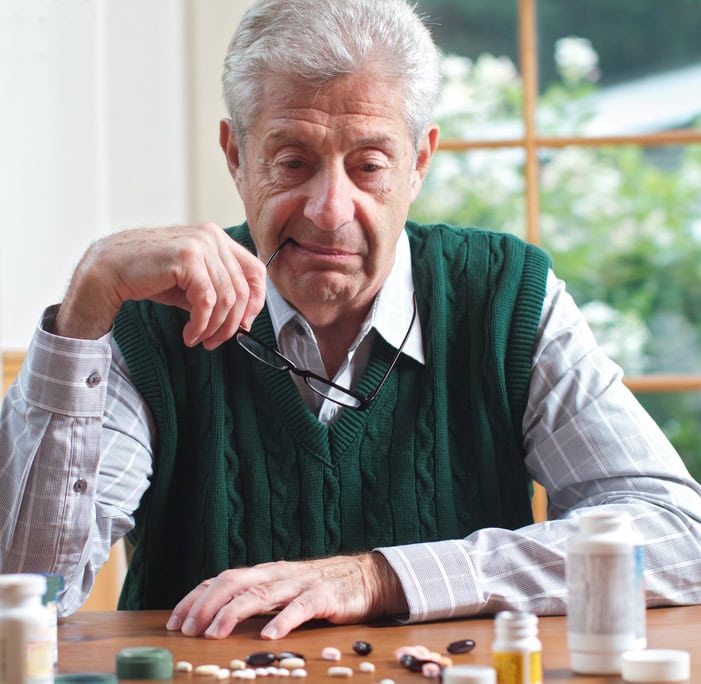
Common Blood Pressure Medicines
Most people with high blood pressure need at least 2 medicines to lower their blood pressure and keep it under control.
It is important to take all of your prescribed medicines, as each works in a different way.
| Drug Classes | What it Does to Treat High Blood Pressure | Common Brand Names |
|---|---|---|
Angiotensin Receptor Blocker (ARB) | Blocks a chemical called angiotensin that tightens your blood vessels, so vessels can widen and lower blood pressure | Losartan (Cozaar), Olmesartan (Benicar), Valsartan (Diovan) |
Beta Blocker | Blocks the effects of the hormone epinephrine (adrenaline) to slow your heart rate and lower your blood pressure | Metoprolol (Toprol), Atenolol (Tenormin), Bisoprolol (Zibeta) |
Angiotensinconverting enzyme (ACE) Inhibitors | Decreases an enzyme which helps your blood vessels relax, so blood has more room to flow through arteries and veins | Lisinopril, Enalapril, Zestril, Ramipril |
Calcium Channel Blocker | Stops calcium from entering cells which relaxes and opens the blood vessels to lower blood pressure | Amlodipine (Norvasc), Cardizem, Procardia |
Vasodilator | Relaxes the blood vessels by dilating (widening) them so the heart can pump blood more easily | Hydralazine, Minoxidil |
Thiazide Diuretic (water pill) | Stops the body from absorbing too much salt and water, which will lower blood pressure | Hydrochlorothiazide (HCTZ), Chlorothiazide (Diuril) |
Central-acting Agent | Block signals from the brain that increase how fast the heart beats and tighten blood vessels which allows the heart to beat easier | Clonidine |
Learn About Your Medicines
Medicine Checklist
Check off the things you do:
- Know the name of each medicine that I take.
- Carry a list of my medicines with me at all times.
- Know how and when to take my medicine.
- Know what side effects I need to report to my health care professional when I take my medicine.
- Tell my health care professional about all of the vitamins, herbs, supplements, and pills I take.
- Never stop taking a medicine without calling my health care professional.
How Do Blood Pressure Medicines Work?
There are many medicines that lower blood
pressure. They all work in different ways.
- Relax the arteries (angiotensin converting enzyme (ACE) inhibitors, angiotensin II receptor bockers (ARBs), and calcium channel blockers (CCBs))
- Remove extra fluid (diuretics)
- Allow your heart to beat more easily(beta blockers)
Tips on Taking Your Medicines
Use a weekly pillbox to help you remember to take your medicine, even if you only take one pill.
- Take your pills at the same time each day. Use a timer or alarm on your watch or phone to remind you to take your medicine.
- Write down on your calendar when you need to refill your medicine – at least 1-2 weeks before you run out.
- When you travel, carry your medicine list, and at least 1-2 days of extra medicine.
- Keep taking your medicines even if your blood pressure is at your goal.
Things to Talk About With Your Healthcare Team
- Ways to make your medicine schedule easier.
- If there are lower cost options for your medicines, such as generics.
- If you don’t feel well after taking a medicine, call your health care professional.
Don’t just stop taking the medicine.
Learn More
Explore these topics further to learn more about blood pressure.
Understanding Blood Pressure
Checking Your Blood Pressure At Home
Exercise and Blood Pressure
Salt and Blood Pressure
Blood Pressure and Weight
Common Medicines for Blood Pressure
Disclaimer: While PCNA strives to provide reliable, up-to-date health information, this and other PCNA education materials are for informational purposes only and not intended as a substitute for professional medical care. Only your healthcare provider can diagnose and treat a medical problem.

